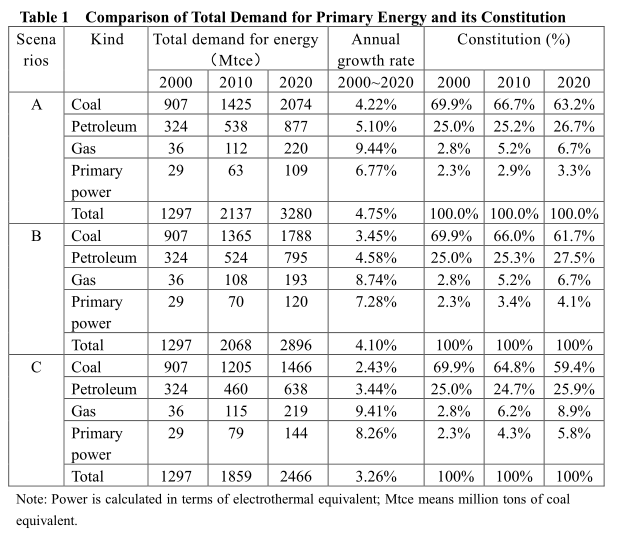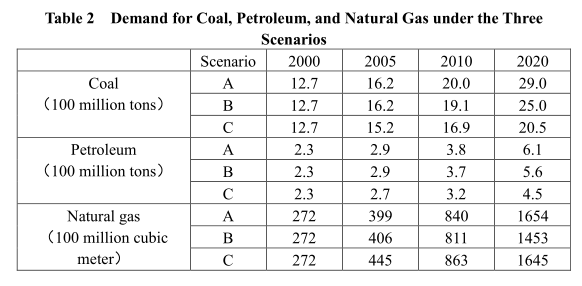Strategic Concept for China’s Energy Development
2004-03-12
Feng Fei
I. China will face relatively severe energy problems in the next 20 years.Whether China could make further progress rests on rational policies to be adopted.
The goal of China is to quadruple its economy by the year 2020 according to the standard of building a well-off society in an all-round way set at the 16th National Congress of the CPC. Calculated in terms of purchasing power parity (PPP), China’s per capita GDP will surpass USD 10 thousand by 2020. According to international experience, the next 20 years is the key period for realizing industrialization and also an important period when obvious changes would take place in economic structure, urbanization level and people’s consumption structure. Most of the developed countries also experienced the processes of rapid growth of energy consumption per capita (especially when the per capita GDP was between USD 3000 to USD 10,000) and rapid change (demand for oil rising proportionally) of energy mix. In light of the special conditions of China and the background of economic globalization and louder calls for environmental protection, the problems facing China are much more complicated than those facing developed countries.
How much energy will be needed in building its well-off society in an all-round way to support the economic and social development objectives, and what challenges and pressures China may face will depend on both the objective laws of economic and social development and the economic, energy and environmental policies which the government may adopt. To illustrate the demand for energy and its social effects by adopting different policies, we provide the following three scenarios:
Scenario A: known as standard scenario where no special policy measures are taken for the policies to bring great effects on energy demand and social benefits.
Scenario B: the related policies will be adjusted accordingly.
Scenario C: regarded as advanced policy scenario where a number of policy adjustment will be made to make the policies practical to highlight the influence of the economic, energy and environmental policies under the prerequisite that these policy adjustments are workable.
What needs to be explained here is that the existing policies cannot be simply used even under Scenario A. Consideration should be given to both the sophistication of relevant policies in force in the sectors of industry, transportation, construction and energy transformation, and the implementation of the policies in contemplation (see attached table 1 for detailed policies). The difference between Scenario A and the other two Scenarios is only the time for implementing policies under consideration.
Please see the attached Table 2 for the difference in policies adopted by different Scenarios.
Table 1 shows the total demand for primary energy, and the energy constitution under the three Scenarios. Table 2 gives the demands for coal, petroleum and natural gas under the three scenarios.


We can draw the following conclusions from the above forecasted results:
First, China promises to keep energy demand growing at relatively lower rate in the next 20 years if right energy strategies and related policies and measures are taken.
Second, while keeping the same economic growth, there would appear difference in energy mix and energy efficiency improvement, due to different policy measures adopted, hence resulting in a big difference possible for demand of primary energy of 800 Mtce by 2020.
Third, with the improvement of people’s living standards and the upgrading of consumption structure, great changes would take place in energy demand mix, especially in the sectors of transportation, and the growth rate of energy demand for buildings will be higher than that of industrial sector and the whole society in the corresponding period. The proportion of the energy consumption of these two sectors to the total new additional energy consumption will increase from less than 35% at present to 57-75% by 2020, gradually becoming the major factors demanding energy growth.
While building a well-off society in an all-round way, China will face a series of challenges in the field of energy.
First, China’s excessive dependence on fossil fuels may put great pressure on its sustainable supply of resources. China’s recoverable reserves per capita are far below the world average level. The recoverable reserves of petroleum per capita was only 2.6 tons in 2000, natural gas recoverable reserves per capita 1074 cubic meters, and coal recoverable reserves per capita 90 tons, equal to 11.1%, 4.3% and 55.4% of the world average level respectively.
The output of China’s petroleum cannot increase considerably, which is estimated to reach 180-200 million tons by 2020 and then the output will fall gradually.
In spite of rich coal resources, the degree of verification was very low in China. The economic concentrate reserves for building new coal mines were only 20.3 billion tons[1] in 2000, which could hardly meet the needs of recent coal mine construction.
Second, while economic and social development depends heavily on energy, it is more difficult than 20 years ago to improve energy efficiency despite the great potential to tap. From the perspective of energy utilization efficiency, the energy consumption per unit product in China is relatively high[2]. At present, the energy consumption per unit product in eight high energy-consuming sectors where the energy consumption takes up 73% of the total energy consumption of industrial sectors is 47% higher than that of the world average advanced level. Compared to the international advanced level from this calculation, China’s industrial sectors consume about 230 Mtce extra.
…
If you need the full text, please leave a message on the website.
--------------------------------------------------------------------------------
[1]. Zhang Rongli et al. Study on Coordinated and Stable Development of Coal Industry and its Development Construction Layout , China Coal , No.4, 2003
[2]. Comparing energy intensity (energy consumption per unit GDP) between countries, there will be great deviation due to the currency conversion. If calculated with nominal exchange rate, China’s energy intensity in 2000 was 9.7 times that of Japan, and 3.4 times the world average level, which shows that China’s energy intensity was overestimated. If calculated with purchasing power parity, China’s energy intensity was just 20% higher than that of Japan and even 8% lower than the average level of OECD member countries, which shows obvious underestimation. Therefore, we choose energy consumption per unit product as the base for comparison.














